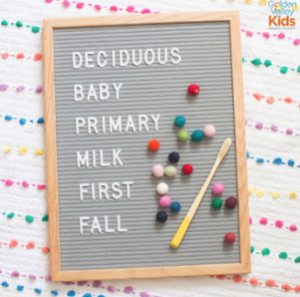Just like children are not little adults, primary teeth (also called deciduous or baby teeth) are not just little permanent teeth.
Anatomically, baby teeth are very different from permanent teeth. The enamel layer (outer surface of teeth) is thinner on baby teeth and more susceptible to decay. The enamel of baby teeth is also whiter than permanent teeth. The pulp chamber, which houses the tooth nerve, is relatively much larger on baby teeth. The roots on baby teeth are also shorter and thinner than permanent teeth.
It is good for baby teeth to have spaces between them. This allows for easier cleaning as you don’t need to floss between baby teeth unless they are touching. Also, if your child’s teeth are not touching, there may not be a need for x-rays because the doctor can visualize all the surfaces of the teeth. Spaces in between baby teeth also mean that there will likely be sufficient room for all those large permanent teeth when they erupt.
Why do we care about baby teeth?
- Form and function: Baby teeth greatly aid in eating and are important for nutrition. They help give faces their proper shapes and help kids speak and pronounce words better.
- Growth and development: Premature loss of baby teeth can lead to loss of space, tilting of teeth, crowding, or impaction of permanent teeth. If baby teeth have decay, this can negatively affect the permanent tooth bud that is forming.
Usually mandibular central incisors #O and #P (the two middle teeth of the lower jaw) will erupt first around 6 months of age. There is a range of normal – some come in earlier and some later. Dr. Borodkin doesn’t worry about timing as much as she cares about symmetry and sequence. Most children have all 20 of their baby teeth by the time they are 2.5 to 3 years old. Baby teeth fall out in 2 phases: the 8 incisors usually fall out between 6 and 8 years old, followed by the 12 remaining baby teeth between 9 and 12 years old. There can be as long as a 2 year break between these 2 phases.
Brush with a soft toothbrush and a light smear of toothpaste as soon as the teeth erupt. It is safe to use fluoridated toothpaste. Recent studies indicate that even if children swallow some toothpaste before they learn to spit, their adult teeth will not be negatively affected.
The American Board of Pediatric Dentistry recommends that children visit the pediatric dentist by the time the first teeth have erupted, or by the age of 1, whichever comes first. Call our office with any questions or to schedule a visit at 763-222-1299.
Let’s Talk Baby Teeth with Dr. Adena Borodkin of Golden Valley Kids Pediatric Dentistry in Golden Valley, MN
Just like children are not little adults, primary teeth (also called deciduous or baby teeth) are not just little permanent teeth.
Anatomically, baby teeth are very different from permanent teeth. The enamel layer (outer surface of teeth) is thinner on baby teeth and more susceptible to decay. The enamel of baby teeth is also whiter than permanent teeth. The pulp chamber, which houses the tooth nerve, is relatively much larger on baby teeth. The roots on baby teeth are also shorter and thinner than permanent teeth.
It is good for baby teeth to have spaces between them. This allows for easier cleaning as you don’t need to floss between baby teeth unless they are touching. Also, if your child’s teeth are not touching, there may not be a need for x-rays because the doctor can visualize all the surfaces of the teeth. Spaces in between baby teeth also mean that there will likely be sufficient room for all those large permanent teeth when they erupt.
Why do we care about baby teeth?
Usually mandibular central incisors #O and #P (the two middle teeth of the lower jaw) will erupt first around 6 months of age. There is a range of normal – some come in earlier and some later. Dr. Borodkin doesn’t worry about timing as much as she cares about symmetry and sequence. Most children have all 20 of their baby teeth by the time they are 2.5 to 3 years old. Baby teeth fall out in 2 phases: the 8 incisors usually fall out between 6 and 8 years old, followed by the 12 remaining baby teeth between 9 and 12 years old. There can be as long as a 2 year break between these 2 phases.
Brush with a soft toothbrush and a light smear of toothpaste as soon as the teeth erupt. It is safe to use fluoridated toothpaste. Recent studies indicate that even if children swallow some toothpaste before they learn to spit, their adult teeth will not be negatively affected.
The American Board of Pediatric Dentistry recommends that children visit the pediatric dentist by the time the first teeth have erupted, or by the age of 1, whichever comes first. Call our office with any questions or to schedule a visit at 763-222-1299.